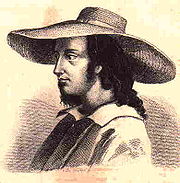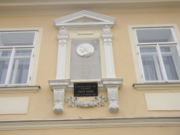
Thaddäus Haenke
Encyclopedia


Geographer
A geographer is a scholar whose area of study is geography, the study of Earth's natural environment and human society.Although geographers are historically known as people who make maps, map making is actually the field of study of cartography, a subset of geography...
and explorer in South America
South America
South America is a continent situated in the Western Hemisphere, mostly in the Southern Hemisphere, with a relatively small portion in the Northern Hemisphere. The continent is also considered a subcontinent of the Americas. It is bordered on the west by the Pacific Ocean and on the north and east...
.
Biography
Thaddaeus Haenke was born of ethnic German extraction in the Bohemian village of Kreibnitz (now Chřibská), near the Sudeten Mountains(today Czech RepublicCzech Republic
The Czech Republic is a landlocked country in Central Europe. The country is bordered by Poland to the northeast, Slovakia to the east, Austria to the south, and Germany to the west and northwest....
) in 1761. A keen observer of nature from childhood, this aptitude was cultivated throughout his education at the Jesuit college in Prague, and later at Carolus University, where he studied medicine, botany and astronomy. He undertook a study of the botany of the Giant Range (Riesengebirge) of the Sudeten Mountains for the Royal Bohemian Academy of Science and, upon obtaining his degree of Magister in 1786, moved to Vienna. His botanical work took him to the Tyrol, Carinthia and Styria. He came to the notice of Ignaz von Born and Nikolaus Joseph Jacquin, influential savants who put his name forward in July 1789 when the Spanish Government was recruiting for the Malaspina expedition. Prior to this, Born had proposed to Emperor Joseph II an Austrian expedition to the Pacific comparable to those led by James Cook. The expedition would have been commanded by William Bolts, of the Imperial Asiatic Company of Trieste. Although the Emperor was initially enthusiastic, the venture eventually proved impossible to realize, principally because of the bankruptcy of the Imperial Asiatic Company of Trieste. The Emperor gave Bolts leave to take his proposal to other courts friendly to Austria, and Bolts put placed it before the French Government, which adopted the concept (though not its author) leading to the sending out of the Lapérouse expedition.
Haenke presumably would have been stimulated by the discussion associated with the schemes for round the world voyages of exploration to consider the advantages of participating in such an undertaking, and in fact he spent the period from September 1787 to May 1788 in anticipation of joining a proposed Russian expedition to the Pacific under the command of Grigory I. Mulovsky. He would have been the assistant to the proposed expedition’s chief scientist, Georg Forster
Georg Forster
Johann Georg Adam Forster was a German naturalist, ethnologist, travel writer, journalist, and revolutionary. At an early age, he accompanied his father on several scientific expeditions, including James Cook's second voyage to the Pacific...
, who had accompanied his father, Johann Reinhold Forster
Johann Reinhold Forster
Johann Reinhold Forster was a German Lutheran pastor and naturalist of partial Scottish descent who made contributions to the early ornithology of Europe and North America...
, on James Cook
James Cook
Captain James Cook, FRS, RN was a British explorer, navigator and cartographer who ultimately rose to the rank of captain in the Royal Navy...
's expedition of 1772-1775. The Mulovsky expedition
Mulovsky expedition
The Mulovsky expedition was a Russian naval expedition planned by Catherine II of Russia, to be led by Captain Grigory Ivanovich Mulovsky Григорiй Ивановичъ Муловскiй...
was prevented from leaving the Baltic by the outbreak of war with Sweden in 1787. Following cancellation of the expedition, Haenke applied to fill the position of Professor of Natural History at the University of Vilna (Vilnius) which Forster had vacated in anticipation of taking up his new post with the Russians, but when preparation of the Malaspina Expedition
Malaspina Expedition
The Malaspina Expedition was a scientific exploration that took place during a five-year voyage around the globe, commanded by Alessandro Malaspina and José de Bustamante y Guerra. Although the expedition receives its name from Malaspina, he always insisted on giving Bustamante an equal share of...
was announced, he expressed interest in joining it. A long journey from Vienna brought Haenke by way of Munich, Strasbourg, Paris, Bordeaux, Biarritz and Madrid (where he was formally received into the expedition as “Naturalist-Botánico de Su Magestad”) to Cadiz just five hours after the two ships of the expedition, the Descubierta and Atrevida, had set sail from that port. He sailed on a following vessel, intending to catch up with the expedition in Buenos Aires. This vessel was wrecked close to Monte Video, and the intrepid Haenke was forced to swim for the shore, salvaging from his luggage (it is said) only his copy of Linnaeus, which he carried in a nightcap. Having in this way missed the expedition again, he hired guides for a trek overland across the pampas and Andes to Santiago de Chile, where he caught up with Malaspina in April 1790.
Thereafter he continued with the expedition during its visits to Peru, Guayaquil, Panama, Guatemala, Mexico, the North West American coast, California, Mexico again, Guam, the Philippines, New Zealand, New South Wales and Vavao, arriving again at Callao, Peru in June 1793. Here he left the ships to again cross overland to Buenos Aires, with the intention of undertaking botanical and other scientific work along the way. Instead, he stayed in Peru, continuing to work as Royal Botanist. In 1810 he was ordered to return to Spain but the political situation caused him to decide to remain in Peru, where he had an estate at Yuracaré, near Cochabamba, in what is now Bolivia. He continued his botanical and other scientific work, remaining in regular contact with his homeland through a Bohemian glass trading company. He died in Cochabamba of accidental poisoning (it is said) in 1816, aged 54.
After he joined it in Santiago de Chile on 2 April 1790 the Malaspina Expedition
Malaspina Expedition
The Malaspina Expedition was a scientific exploration that took place during a five-year voyage around the globe, commanded by Alessandro Malaspina and José de Bustamante y Guerra. Although the expedition receives its name from Malaspina, he always insisted on giving Bustamante an equal share of...
lasted another three years during which Haenke collected several thousand plants. During the expedition’s stay at Sydney Cove, New South Wales, in March–April 1793, he carried out observations and collection relating to the natural history of the place, as he reported to the colony’s patron, Sir Joseph Banks.
Haenke's work in Peru
Peru
Peru , officially the Republic of Peru , is a country in western South America. It is bordered on the north by Ecuador and Colombia, on the east by Brazil, on the southeast by Bolivia, on the south by Chile, and on the west by the Pacific Ocean....
, Bolivia
Bolivia
Bolivia officially known as Plurinational State of Bolivia , is a landlocked country in central South America. It is the poorest country in South America...
, and Chile
Chile
Chile ,officially the Republic of Chile , is a country in South America occupying a long, narrow coastal strip between the Andes mountains to the east and the Pacific Ocean to the west. It borders Peru to the north, Bolivia to the northeast, Argentina to the east, and the Drake Passage in the far...
finally contributed to the creation of the smallpox vaccine
Smallpox vaccine
The smallpox vaccine was the first successful vaccine to be developed. The process of vaccination was discovered by Edward Jenner in 1796, who acted upon his observation that milkmaids who caught the cowpox virus did not catch smallpox...
. During his expedition through the Atacama desert, he discovered a method for transforming Chile saltpeter
Sodium nitrate
Sodium nitrate is the chemical compound with the formula NaNO3. This salt, also known as Chile saltpeter or Peru saltpeter to distinguish it from ordinary saltpeter, potassium nitrate, is a white solid which is very soluble in water...
and Potassium chloride
Potassium chloride
The chemical compound potassium chloride is a metal halide salt composed of potassium and chlorine. In its pure state, it is odorless and has a white or colorless vitreous crystal appearance, with a crystal structure that cleaves easily in three directions. Potassium chloride crystals are...
into Potassium nitrate
Potassium nitrate
Potassium nitrate is a chemical compound with the formula KNO3. It is an ionic salt of potassium ions K+ and nitrate ions NO3−.It occurs as a mineral niter and is a natural solid source of nitrogen. Its common names include saltpetre , from medieval Latin sal petræ: "stone salt" or possibly "Salt...
. Furthermore, he improved explosives and gun powder, giving his results to the Spanish army
Spanish Army
The Spanish Army is the terrestrial army of the Spanish Armed Forces responsible for land-based military operations. It is one of the oldest active armies - dating back to the 15th century.-Introduction:...
.
He was the first European to discover the largest water lily Victoria amazonica
Victoria amazonica
Victoria amazonica is a species of flowering plant, the largest of the Nymphaeaceae family of water lilies.-Description:The species has very large leaves, up to 3 m in diameter, that float on the water's surface on a submerged stalk, 7–8 m in length. The species was once called Victoria...
(in 1801) and advocated the medicinal benefit of hot springs
Hot Springs
Hot Springs may refer to:* Hot Springs, Arkansas** Hot Springs National Park, Arkansas*Hot Springs, California**Hot Springs, Lassen County, California**Hot Springs, Modoc County, California**Hot Springs, Placer County, California...
.
Haenke Island
Haenke Island
Haenke Island is an island located in Disenchantment Bay in Alaska. It was named in 1791 by Alessandro Malaspina for Thaddäus Haenke, who was serving as botanist and naturalist with Malaspina's expedition. The island is part of Yakutat City and Borough....
in Alaska and the plant Juncus haenkei were named after him.
Work
- Carl Bořivoj Presl Reliquiae Haenkeanae : seu descriptiones et icones plantarum, quas in America meridionali et boreali, in insulis Philippinis et Marianis collegit Thaddaeus Haenke. J.G. Calve, Prague, 1830. Botanicus

